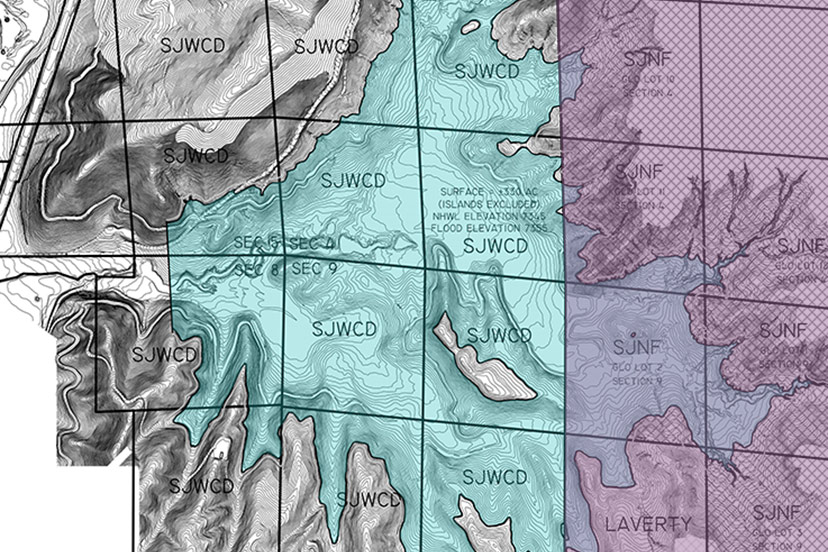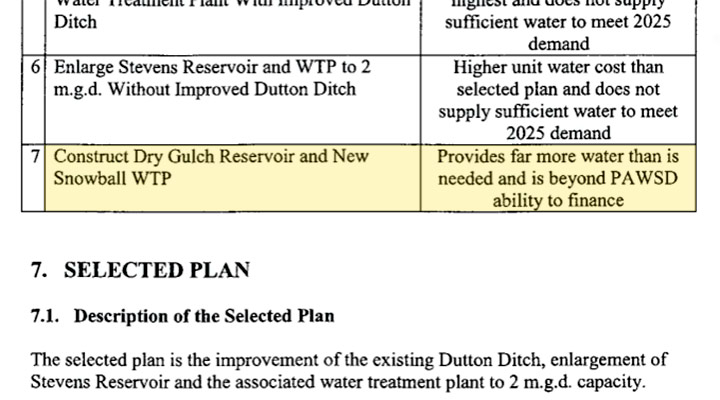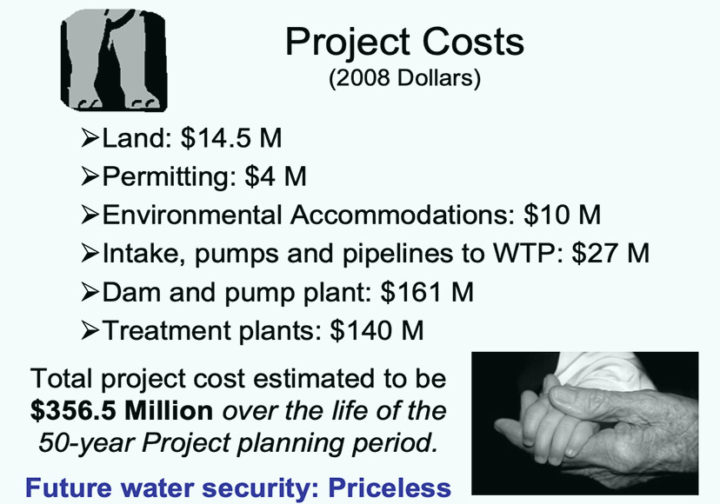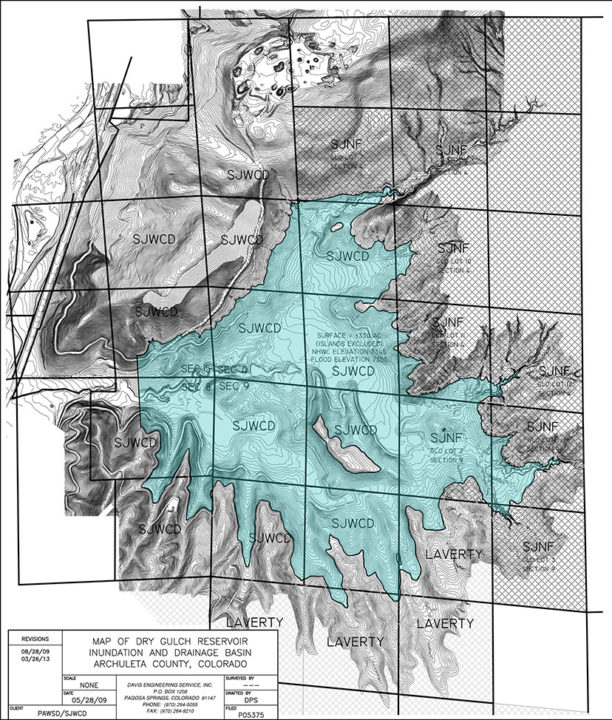We concluded Part Two by noting that water engineer Steven C. Harris signed his name to two different reports in 2003, both delivered to Pagosa Area Water and Sanitation District (PAWSD).
The first report, in January 2003, stated that, in the case of the proposed Dry Gulch Reservoir, “the existing rate payers are not able to finance the debt service to construct this large project and the existing water distribution system has insufficient capacity to utilize the large yield.”
That conclusion was repeated in an included chart.
The “Selected Plan” was, instead, to enclosed the Dutton Ditch diversion, and to enlarge Stevens Reservoir. Both those projects were subsequently completed by PAWSD.
Disclosure: I currently serve on the Pagosa Area Water and Sanitation District (PAWSD) board of directors, but this editorial reflects only my own personal opinions, and not necessarily those the PAWSD board as a whole.
We note that the size of the Dry Gulch Reservoir, in Mr. Harris’ January 2003 report, was 4,000 acre feet. At that size, the Dry Gulch Reservoir would have roughly doubled the amount of PAWSD water storage. But it would be too big, too expensive, and too impractical.
Oddly enough… just two months later, in March 2003… Mr. Harris submitted a second report to PAWSD and the San Juan Water Conservancy District (SJWCD). In that report, he wrote:
Dry Gulch Reservoir is the least costly storage alternative for any size reservoir. Dry Gulch Reservoir could be constructed to provide all of the storage requirements.
Was anyone confused by this? Apparently not. Under the guidance of SJWCD president Fred W. Schmidt, the PAWSD and SJWCD boards voted unanimously to invest $10 million into purchasing the Running Iron Ranch in the Dry Gulch valley, owned at the time by the Weber family.
The Webers had acquired the property in February 2003, the one month before engineer Steven C. Harris declared it to be the best site for a new reservoir.
Fred W. Schmidt negotiated the $10 million purchase price with the Weber family, oversaw the property transfer, and then disappeared from the community, never to be seen again.
I later learned that Fred W. Schmidt’s full name was Fred Weber Schmidt.
Steven C. Harris was then hired to further assess the proper size of the Dry Gulch Reservoir, which somehow grew to 35,000 acre feet — roughly nine times the size that he had determined to be too big and too expensive in January 2003.
The new, larger, more expensive project was unanimously approved by the PAWSD and SJWCD boards. In 2009, the project cost was estimated. Here’s a slide from a 2009 PAWSD Power Point presentation:
Project cost: $356.5 million, for a reservoir with an adjoining pumping station and treatment plant.
Sportsmen’s association Trout Unlimited challenged the project size at the Colorado Supreme Court, and the court agreed that the size was unjustified and essentially amounted to ‘water speculation’ — something that’s prohibited in Colorado. In writing the Supreme Court opinion, Justice Greg Hobbs stated:
The evidence currently of record does not demonstrate that the Districts have carried their burden of proving a non-speculative intent to put the water amounts contained in the remand decree to beneficial use and, under the “can and will” test, a substantial probability that the intended appropriations will reach fruition…
The attorneys for Trout Unlimited and the attorneys for PAWSD and SJWCD sat down behind closed doors and formulated a compromise, which was later accepted by District Court Judge Greg Lyman.
The compromise? 11,000 acre feet of storage. Such a project would roughly quadruple the amount of PAWSD water storage, suggesting that Pagosa Springs would need to quadruple in size in order to make full use of the proposed reservoir.
Subsequently, voters elected a crop of (more intelligent? more conscientious?) directors to the PAWSD board, and the Dry Gulch project was pulled from the district’s Capital Improvement Plan.
But the San Juan Water Conservancy District — under the leadership of disbarred attorney Rod Proffitt — continued spending tax money chasing the project, knowing full well that PAWSD was philosophically opposed to an 11,000-acre-foot reservoir.
President Rod Proffitt had signed an oath, when he joined the SJWCD board, stating that he would simultaneously serve on the SJWCD board and also work as a contractor for SJWCD. In spite of this oath, president Proffitt subsequently signed a contract with SJWCD and proceeded to earn thousands of dollars working as their contractor. When this (apparently illegal?) contract was discovered, Mr. Proffitt was exposed in the local media, and subsequently resigned from the board… and then put in an application to be hired as the SJWCD’s new ‘general manager’.
The board declined to hire Mr. Proffitt.
After Rod Proffitt resigned from the SJWCD board, however, the remaining board continued to advocate for an 11,000-acre-foot reservoir in the Dry Gulch valley.
That’s when I joined the SJWCD board, with two goals in mind — one goal being, to convince the SJWCD board members that Dry Gulch had been a boondoggle from the start, and had been promoted, based on flawed data.
And the second goal being, to write about the SJWCD in the Daily Post, as an ‘insider’ with access to SJWCD discussions and documents.
It was this second goal that caused current SJWCD president Al Pfister to appeal to District Court judge Jeffrey Wilson to deny my request for another term on the SJWCD board.
The judge determined that I posed a problem for certain other SJWCD directors, and rejected my re-appointment.
Of course, ‘posing a problem’ was exactly my intention in joining the board. To challenge any board members who continued to embrace the Dry Gulch boondoggle, which was too big and too expensive in January 2003, but suddenly became a great idea one month after the Weber family acquired the Running Iron Ranch.
On June 20, four applicants were interviewed by the SJWCD board for vacant board seats, and we heard applicant Bill Nobles express his support for the Dry Gulch project.
“Water in general, you know, we think about it just falling from the sky. And people don’t realize, when it turns hotter and drier, you don’t have the rains; you have the winds. And storage of water actually generates more water. Research shows that, by having water — it goes up into the sky and then it comes back down. And when you have water here, it actually helps with this.
“You take a look over in Durango and what’s happening over there. I’ve been gone ten years, and I swear, you can see that it’s drying up. Even the piñon and juniper are suffering.”
Interesting theory from Mr. Nobles, that “research shows” reservoirs improving rainfall. I’d love to see that research, because Durango has one of the largest reservoirs in southwest Colorado… and yet, it’s drying up? And the two largest reservoirs in the U.S. — Lake Mead and Lake Powell — have dropped to about 25% of capacity. Where did all the ‘reservoir-generated’ rain go? I wonder.
Mr. Nobles continued, somewhat coherently.
“What we can do to actually sell that aspect to our community… I realize people understand that water is important; I don’t think you can walk up to anyone on the street and not… because when they see what happens to water bills, the cost of their domestic water usage, it’s… we are… we’re prone to make a big push, right now, to move forward to do what we need to do, and I think you’re on the right track.
“We just need some more help, and get this thing pushed over the top and take care of the storage aspect of it.
“But there’s more to it than that.”
I agree with Mr. Nobles, that people are concerned when their water bills go up, and that there’s a lot more to the Dry Gulch controversy than meets the eye.
For example. What does Mr. Nobles imagine would happen to our water bills, if a Dry Gulch reservoir actually got built? If our water districts were able to borrow enough money to fund such a project?
Can anyone guess what an 11,000-acre-foot reservoir might cost, in today’s economy?




